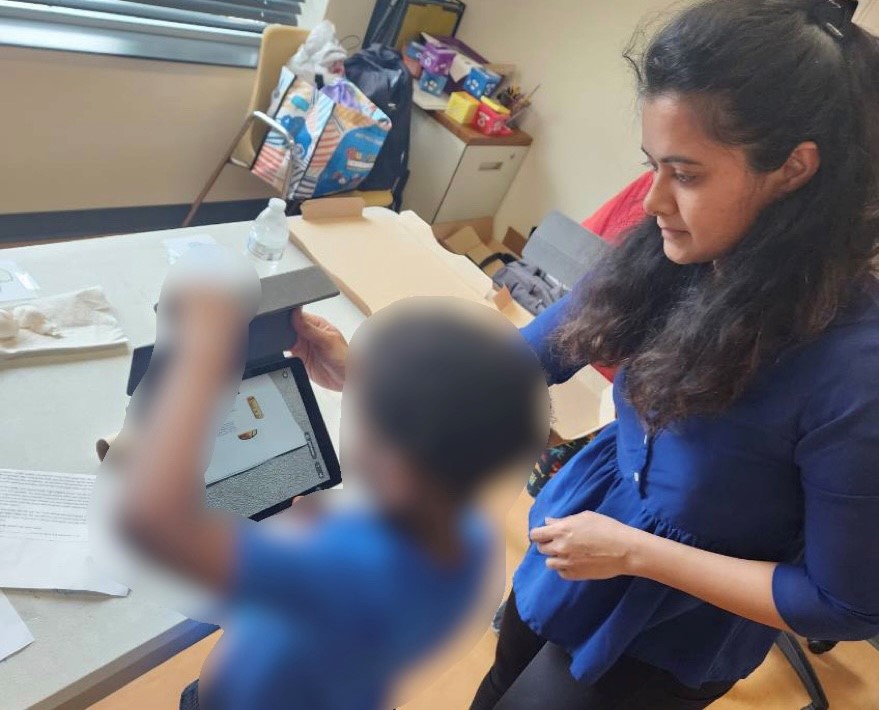Using AR to promote learning at local after school program
A team of Purdue educators are using augmented reality (AR) to promote environmental sustainability among underrepresented students at a local after school program in Lafayette, Indiana.

and William Watson (All photos provided by William Watson and team)
William R. Watson, professor of learning design and technology (LDT) in the College of Education, is the director of the Purdue Center for Serious Games and Learning in Virtual Environments. He oversees the environmental sustainability service project with three LDT doctoral students, Deepti Tagare, Anthony Ilobinso, and Chi-Jia Hsieh, who designed, developed, and facilitated the project.
“We conceived the idea for this project in response to the announcement made by Nadine Dolby, professor of curriculum studies and the College of Education Diversity Fellow for 2022-2023, regarding the availability of service grants for student-led projects in collaboration with non-profit organizations in Tippecanoe County,” Tagare said. “We shared our project idea with both Dr. Dolby and Dr. Watson, who subsequently connected us with Wonderland Education and Hanna Community Center. These non-profit organizations, situated in West Lafayette and Lafayette respectively, played a vital role in the successful implementation of the project.”
The service project, funded by the College of Education’s Diversity Fellow grant led by Dolby, aimed to promote an awareness of environmental sustainability among diverse students (ages 6-9 years) by holding a three-session workshop at the Hanna Community Center in Lafayette, IN, during the spring of 2023.
To achieve this goal, the Purdue team organized a three-session workshop involving augmented-reality (AR) based hands-on activities, storytelling, and play based learning. Under Watson’s guidance and supervision, the team conceptualized the workshop structure, designed augmented reality environments and activities, and implemented these activities with the students.
During these sessions, the young learners were virtually transported to a wetland habitat where they explored the flora and fauna and were engaged in specially designed AR activities that focused on educating them about recycling and the reuse of waste materials.

Topics of the three sessions were: “Exploring wetland flora and fauna through Augmented Reality,” “Exploring wetland flora and fauna through interactive storytelling in Augmented Reality,” and “Waste sorting and recycling activities through AR.”
“The primary goal was to create awareness about environmental sustainability among diverse students from local minority communities while also offering them the opportunity to interact with an emerging technology like augmented reality,” Tagare said. “A second goal of the project was also to study whether and how augmented reality based learning environments impacted students learning in an after school program.”
The Purdue team learned new things as they observed young learners at the Hanna Community Center.
“It was fascinating to observe how the use of AR technology fostered collaboration among students, particularly between older and younger participants, while effectively raising awareness about environmental sustainability,” Ilobinso said.

“It was great to see that the AR activities generated excitement and enthusiasm for learning among learners enrolled in the after school program,” said Tagare. “The immersive augmented reality environment allowed the students to readily engage with realistic experiences by bringing the wetland habitat, including the animals, birds, water, and experiential knowledge to students’ palms!”
Through the workshop, the Hanna Community Center participants learned about the importance of safeguarding and preserving the Earth. The Purdue team hopes that these young learners cultivate attitudes necessary for making informed decisions and assuming responsibility for the well-being of the environment.
For the wider community, the project gave insights into how after school programs can enrich its educational offerings through using technologies like AR to create immersive, innovative, and collaborative learning experiences beyond the boundaries of the traditional classroom. The Purdue team hopes the project will give more learning opportunities to young learners.
Besides learning themselves, the Purdue team benefited from the research collaboration experience with Dolby and with Tong Jin Kim, professor of Industrial Design at Purdue and the chief executive officer of Wonderland Education, and Tracy Orbin, executive director, IMHC Coalition Director of Tippecanoe County at the Hanna Community Center.

Most of all, the Purdue team was glad to see that their AR project made a difference, and they generously donated some of the learning resources they developed and used for this project to the Hanna Community Center.
“It was amazing to see how creative students can be when provided with technology tools such as AR and how they were able to connect their prior knowledge and learning experiences with the subject of environmental sustainability,” said Hsieh.
“Integrating and harnessing emerging technologies like AR in after school programs has the potential to significantly enhance the educational experiences of students,” Ilobinso said. “I truly believe that AR is exceptionally well-suited for promoting learning within the flexible and relaxed contexts found in after school programs.”
The Purdue team is currently analyzing the collected data, and the next steps involve synthesizing the findings and sharing them through academic publications and conference presentations.
Sources: William R. Watson, brwatson@purdue.edu; Deepti Tagare, Anthony Ilobinso, and Chi-Jia Hsieh